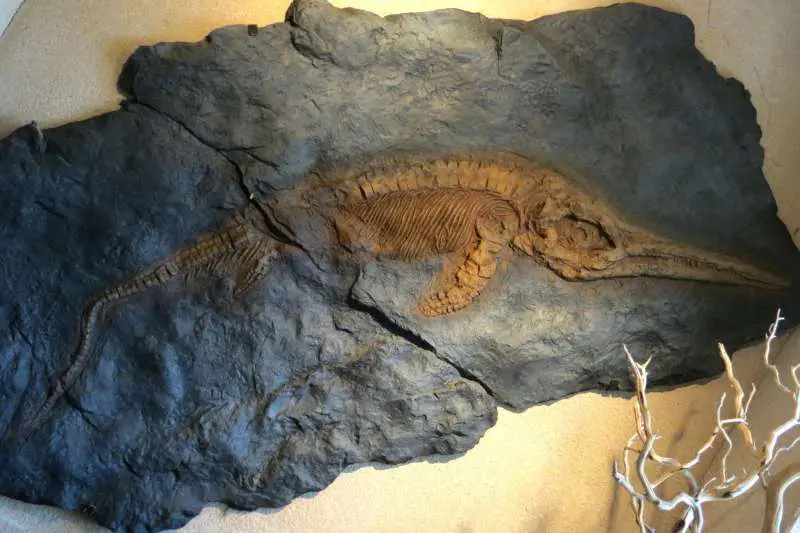[Originally published as part of Echoes of the Jurassic]
Why would the fossil record of Sea Dragons, like fish, be significantly better than their terrestrial counterparts?
Samuel Tutin and Robert Butler published a paper in the Acta Palaeontologica Polonica, a quarterly international Paleontological journal titled, “The completeness of the fossil record of plesiosaurs, marine reptiles from the Mesozoic” (2017). It was a report with some good news. Even though the archives of fossil records are flawed concerning the assessment of the Sea Dragons, the fossil record gives hope.
They compiled 178 specimens of 114 different species of the plesiosaur and came to the conclusion that “significantly higher median completeness values in plesiosaurs and ichthyosaurs than in contemporary terrestrial groups support the hypothesis that the marine tetrapod fossil record is more complete than that of terrestrial tetrapods.” The verdict is that the fossil record for the Sea Dragons is significantly more complete than for the four-footed dinosaurs.
This unusually fine fossil preservation is probably due to the bottom waters at Holzmaden being inhospitable to life because of the absence of oxygen. Any ichthyosaur dying and sinking to the sea floor would lie undisturbed because of the absence of scavengers (crabs, small fish, etc.) picking the body apart. Fine mud would eventually cover the carcass, recording the delicate skin as a dark silhouette. The Ultimate Dinosaur, Editors: Byron, Preiss and Robert Silverberg, October, 1992, p. 234
Don’t fish float when dead, and should that also include sea dragons? Predators will eat them, even before they sink to the bottom. Their large bones can easily separate and disarticulate in salty water conditions before ever reaching the bottom. How can they fall through the sea and be so well preserved?
In the Institute of Creation Research (ICR) article on Sea Dragons, Mac Baker asks these important questions. The article includes a quote from Steve Parker from the Encyclopedia of the Age of Dinosaurs (2000) in which he states, “Hundreds of beautifully preserved skeletons, with the bones still joined, or articulated, as in life, have been found.”
Baker includes the discovery of the Pterosaur, a flying dinosaur whose remains were discovered in an ichthyosaur’s stomach. This bizarre activity, where a Sea Dragon makes a meal of an extinct flying reptile, is like a photo taken during an extremely quick burial.
The only logical explanation is that it came from a catastrophic burial of an undigested meal demonstrated for all to see.
Another fossil testimony of abrupt and rapid burial is the discovery of at least two ichthyosaurs that were blanketed so rapidly that they were fossilized while giving birth to their young. It appears that the biblical account of the worldwide catastrophic flood would be a logical deduction for the cause of such a quick burial of these magnificent creatures.
Ichthyosaurs Weren’t the Only Ones Buries so Quickly
Similar to these testimonies is the Green River Formation, which represents one of the largest fossil graveyards in the world. It spreads over 25,000 square miles with an average thickness of 2000 feet. Paleontologists have identified enormous amounts of excellently preserved fish fossils that are exquisite in every detail, including fish caught in the act of eating other fish.
These examples are caught in a split second of time. It is like the shutter on a camera letting in a glimmer of light, capturing in an instant a scene of history from within the Green River rocks. How could such a testimony be ignored by evolutionists? With this kind of exceptional preservation, this is clearly a catastrophic event demonstrated in the extraordinary fish fossils found in this limestone grave.
Moving Forward
As we address a contradictory fossil record, we take note of the research going on with the discovery of soft tissue found in allegedly ancient creatures, including dinosaur bones. There has been a series of research projects to demonstrate that dinosaurs are not millions of years old but fit more comfortably within the biblical timeframe of several thousand years.
An excellent DVD, The Echoes of the Jurassic: Discovery of Dinosaur Soft Tissue, has been produced by the Creation Research Society. As they share their findings, we can see that only a biblical timeframe can explain the presence of soft tissue in allegedly 70 million-year-old or older specimens. This easy-to-understand documentary takes you to interesting dinosaur dig sites and allows you to witness the evidence that powerfully affirms God’s Word!
Yours in Christ,
Tom DeRosa
Executive Director of CSI






